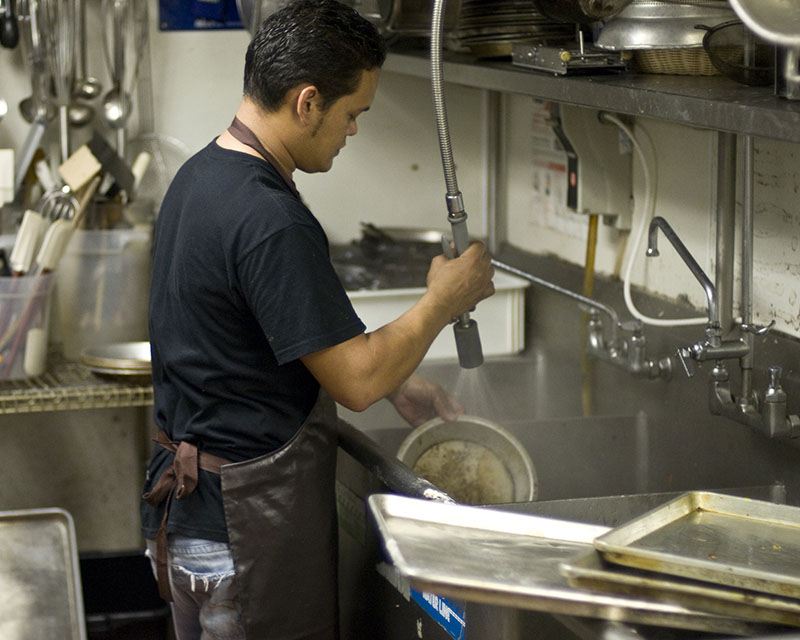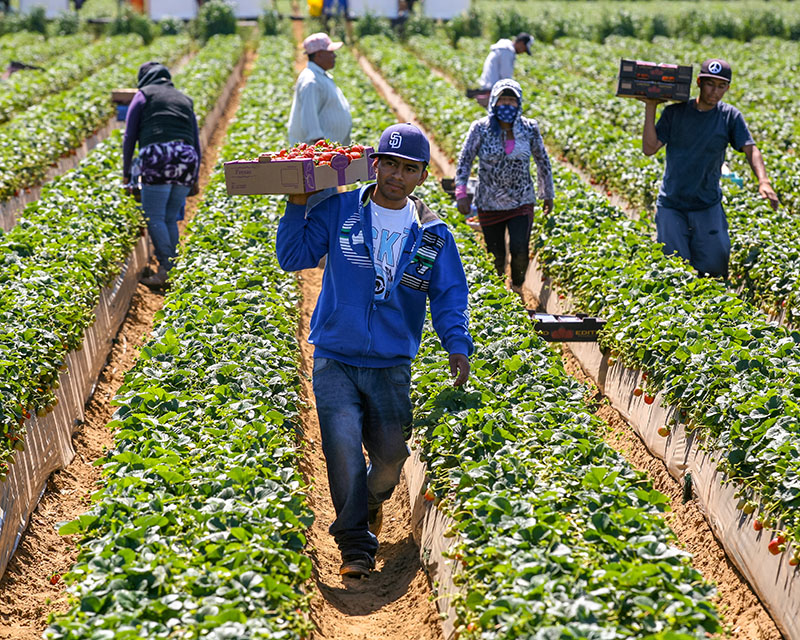Labor Trafficking: The basics

Real labor trafficking storylines
Below are the kinds of labor trafficking situations that we hear about most frequently on the U.S. National Human Trafficking Hotline. They are by no means the only ways that labor trafficking can occur, but taken together may help you craft your own stories in ways that are realistic and impactful.
“Most labor trafficking victims in the U.S. are immigrants, but they are not necessarily undocumented immigrants – that’s a myth.”
– A survivor of human trafficking

Migrants, immigrants and domestic work
- Recruitment and grooming: A diplomat entices someone from her home country with an offer to come to the United States and care for her children. They promise the worker a good wage and the opportunity for her to go to school here. The diplomat repeatedly tells the worker how lucky she is for the opportunity she would never get at home. If she returns home without having completed the job, she will be ashamed because so many people in her community are desperate for better opportunities.
- Coercion and control: When she gets here, the worker is told she will sleep in a closet and is also responsible for keeping the house and yard, and making and serving all meals. Her passport is taken and she is told she can’t leave the house without permission. When she complains, the employer threatens her family in her home country and says she will call ICE and have the worker arrested for being here illegally.
- Exit: The worker sneaks a phone call to a community center for people from her country and gets help. The trafficker is never punished.

Domestic work in marriage
- Recruitment and grooming: A man from a conservative, patriarchal society promises a poor girl’s family he will marry and take care of her in the United States. She has been raised her whole life knowing she will have an arranged marriage.
- Coercion and control: Once here, the wife is forced to take care of the husband’s children from another relationship, keep the house, work in the family business and not leave the house. She has no money and does not speak the language. Her husband tells her complaining will bring shame on her family and ruin her sister’s chances of a good marriage.
- Exit: The wife befriends someone in her religious community – the one place she is allowed to socialize – and the friend helps her find a lawyer.

Exploitation of disabilities
- Recruitment: A couple befriends a woman with a developmental disability and promises her safety and shelter in return for help around the house.
- Coercion and control: The victim is put to work in a family business for long hours every day and not paid. She is told if she doesn’t like it, they will send her to a halfway house that is more like a prison. They cash her disability check monthly.
- Exit: The victim’s family, who has lost track of her, finds her and brings her home.

Exploitation of addiction
- Recruitment: A person struggling to stay clean from drugs joins a spiritual community that lives under the guidance of a charismatic leader.
- Coercion and control: The formerly addicted person is put to work making and selling crafts in abusive conditions for no pay. Those who complain are expelled from the community, which they have come to depend upon in order to maintain sobriety.
- Exit: The victim collapses from exhaustion and hospital staff recognize she needs help and connect her with services.

Fraudulent job offers
- Recruitment and grooming: A mid-level manager in India is offered a dream job that sounds like a promotion in the United States. When the family gets here, the trafficker tricks them out of their savings, takes out a loan under their name, and then tells them they are working in the back of a restaurant washing dishes.
- Coercion and control: The family is not paid and has no money to escape. The trafficker tells them if they complain to the police they will be arrested and separated from their children because they entered the country illegally.
- Exit: One of the children’s teachers notices they have no winter coats and goes to visit the family. They confide in her and she helps them seek legal assistance.

Recruitment fees and debt bondage
- Recruitment and grooming: A 25-year-old man from an Indigenous community in Mexico learns on social media about a job at a farm in the United States. The job comes with a legal, temporary visa and is well paid. In his hometown, most of the adults take these kinds of jobs overseas for half the year to support their families.
- Coercion and control: He is told by the recruiter that it costs $5,000 for the visa but the advertised wages make it worthwhile, so the worker borrows the money from his new employer. When he gets here, he is told he is working off the debt the business owner incurred bringing him here and will not be paid for the first several months of work. Soon, his boss begins charging him for water, lunch, and transportation to and from the work site. His debt is increasing at a rate that will be extremely difficult to pay back. If he leaves, he will have no way to pay back the money he borrowed. The boss tells him he will be barred from ever returning on a legal visa. Although there is no such thing as an official blacklist, the worker knows that his boss knows many of the recruiters who come to his town, so it would be impossible to get work in the future. He feels he has no choice but to stay and try to pay off the debt.
- Exit: Too concerned about being blacklisted for the future, the worker decides to just get through the abusive situation and try for a better position next year. His parents have to sell their home and move in with relatives to pay their debt.
Sex Trafficking: The basics

Real sex trafficking storylines
Below are examples of the kinds of sex trafficking situations that we hear about most frequently on the U.S. National Human Trafficking Hotline. They are by no means the only ways that sex trafficking can occur, but taken together may help you craft your own stories in ways that are realistic and impactful.
“Understanding what happened to you as trafficking is a really important part of healing, but it took me 10 years to realize: Hey. Wow. I was trafficked, because my situation was so different from what I had seen represented as trafficking.”
– A survivor of human trafficking

Romeo pimps or “boyfriending”
- Recruitment and grooming: A man and a woman meet briefly at a party and afterwards, he follows her on social media. He contacts her after she posts about a breakup with her baby’s father. He is everything she ever dreamed of – a great listener, very supportive. He showers her with gifts. She is deeply in love and believes she has found the person she will build her family with. One night he takes her to a party and he tells her to be “nice” to his friends – to earn jewelry. He makes it seem like it’s no big deal at first, so she does it. But then it becomes more frequent.
- Coercion and control: He keeps all the money she earns and tells her he is saving for them to buy a house. Sometimes he hits her to help her understand how much he needs for her to contribute. He says he will stop loving her and she will be alone again if she keeps making trouble.
- Exit: After he blackens her eye, she packs up a “go” bag, calls a friend and escapes when her trafficker is out of the house.

Familial trafficking
- Recruitment and grooming: Mom is a survivor of rape and abuse who has been prostituting for many years. In her community, there are few options for young people and she is already struggling to support her children. When men start expressing interest in one of the kids, she tells her it’s time to contribute to the household and takes her out on the streets.
- Coercion and control: The child loves her mother, and has no other means of support.
- Exit: A teacher notices the child is tired all the time and appears frightened and asks if she needs support. The child confides in her and a social services team comes together to work out a safe place for her to stay.

Child trafficking
- Recruitment and grooming: A parent sexually abuses a child himself, and offers the child to others for sexual gratification in exchange for access to other young children.
- Coercion and control: The child has been taught that this kind of activity is ‘normal’ for parents and children and warned not to tell anyone or they will be hurt. NOTE: Coercion or control is not legally required for this to be considered trafficking because the victim is a minor.
- Exit: An ER doctor notices signs of sexual trauma and alerts child protective services to check on the family after the visit.

Online Trawling
- Recruitment and grooming: A lonely, insecure teen dreams of a modeling career and frequently posts pictures of herself striking a pose. She is contacted by someone who claims to be a modeling agent and sends her a plane ticket to come to his studio. When she arrives, he takes her out on the town and tells her she has to “be nice” to some people in the business to get contracts and sends her out to prostitute.
- Coercion and control: She is far from home, didn’t tell her parents she was leaving, has no money and is ashamed. He tells her she is making a good impression, and that it will just take a little longer for her hard work to turn into modeling jobs.
- Exit: Eventually the child contacts a friend, who tells her family where she is and she is extracted from the situation.

Survival sex
- Recruitment and grooming: A teen who identifies as queer runs away from home in a small Texas town when his stepfather beats him up for his sexual identity. He camps out in a bus station and meets other runaways who tell him about someone they know in Houston who will probably let him stay at his house – for a price.
- Coercion and control: The person who owns the house is very straightforward about the arrangement. The teen can stay there as long as they provide sex to the homeowner and occasionally, other friends. The teen does not have any other options for housing and is also seeking a community, which he hopes to find with the homeowner.
- Exit: The teen meets other young people who have run away. They connect him with a supportive shelter situation and he returns to school.

Exploitation of addiction
- Recruitment and grooming: A trafficker hangs outside the municipal courthouse chatting up people as they come out of drug court, where they were busted for use charges. He offers them drugs for free, and slowly feeds their addiction. Soon, in order to access drugs, the trafficker tells them that they have to engage in sex acts for money.
- Coercion and control: Whenever the victim begins to talk about getting clean and getting out of prostitution, stripping, or porn, the trafficker gives them more drugs and builds their dependency. He also warns that he will report their drug use to their probation officer if they leave.
- Exit: The victim contacts the National Human Trafficking Hotline, which helps them find a space in a drug rehab facility.

Exploitation of disabilities
- Recruitment and grooming: A young adult with a developmental disability and limited family support is placed in a group living facility.
- Coercion and control: At the home, residents are told that sex with strangers is part of what they are expected to do to earn their meals and rent.
- Exit: After many complaints from family members of other residents who have left the home, it is finally shut down and the residents are sent to other safe facilities.

Gangs
- Recruitment and grooming: A young woman grows up in a neighborhood where gangs control most of the commercial activity and the streets. She joins them for protection and a sense of belonging, and because there are few other options available. The gang tells her she has to engage in prostitution and give them the proceeds to help them pay a drug debt they owe to a rival gang.
- Coercion and control: If she leaves the gang, her family, their home and their business will be targeted for violence.
- Exit: When the gang is targeted in a police raid involving drugs, she is swept up by a trauma-informed police officer who understands the situation and connects her with appropriate supports.

“CEO pimping”
- Recruitment and grooming: A young woman who grew up in foster care ages out and is left without a place to live or guidance for her future. She meets a man at her job at a gas station who tells her he has connections in the entertainment industry and she should come dance at his strip club where she will meet producers who might need an assistant. After a few weeks, he tells her the reason she isn’t getting noticed is that she does not perform sex acts in the club’s back room after her shift ends.
- Coercion and control: When she doesn’t comply, he threatens to fire and blackball her from any other clubs or music venues in the city. He also makes veiled threats about hurting her and her young child.
- Exit: She stays until she is able to save enough money to quit and begin community college.